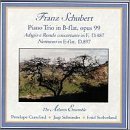| All Artists: Franz Schubert, Atlantis Ensemble, Jaap Schroeder, Enid Sutherland, Penelope Crawford, David Cerutti Title: Piano Trio in B-flat Op 99, Adagio e Rondo concertante, Notturno by Atlantis Ensemble Members Wishing: 0 Total Copies: 0 Label: Wild Boar Records Release Date: 10/13/1998 Genre: Classical Styles: Chamber Music, Symphonies Number of Discs: 1 SwapaCD Credits: 1 UPC: 797551970325 |
Search - Franz Schubert, Atlantis Ensemble, Jaap Schroeder :: Piano Trio in B-flat Op 99, Adagio e Rondo concertante, Notturno by Atlantis Ensemble
 | Franz Schubert, Atlantis Ensemble, Jaap Schroeder Piano Trio in B-flat Op 99, Adagio e Rondo concertante, Notturno by Atlantis Ensemble Genre: Classical
|
Larger Image |
CD Details |
CD ReviewsA great work and other delights performed with intelligence Craig Matteson | Ann Arbor, MI | 02/11/2006 (5 out of 5 stars) "This disk is a great treat. The Trio in B-flat Opus 99 is a later work (sometime in 1827 or 1828, depending on the timeline you want to believe) and has a great deal of sophistication to go along with its high spirits. Some seem to think that unless a work is full of tragedy and pain that it cannot also have profundity. In my book, it is joy that is the greatest human emotion. To be able to evoke it without first taking us into darkness is a testament to Schubert's genius and not evidence of shallowness in any way.
The opening movement opens with sharp lines and lets us know how Schubert intends the violin, cello, and piano will state and develop their musical roles in this work. The dotted rhythms and strings of sixteenth notes not only bring vitality to the work, but, since this is being performed on period instruments, they also emphasize the way these instruments speak. There is more character to the attacks on the notes (you might call it noise) that nicely contrast the more sonorous lyrical sections. The piano has a much lighter sonority and sustains less than a modern grand and it works so well for this music. The second movement is, for me, the real treasure of the work. It a ternery (ABA) form that Schubert used so well. Lyrical outer portions and a turbulent middle sention. The first them is introduced by the cello with the piano accompanying, it is then passed to the violin and then shared by both strings. It is a gorgeous melody that eventually finds its way to the piano while the strings turn what was accompaniment into melodies for development. The stormy middle section contrasts in temperment, but still uses elements from the A section, as if it were part of a variation form. Schubert then combines the elements of both sections into the recapitulation and manages a fabulously sweet ending. The scherzo is a perfect course to follow the feast of the first two movements. The opening theme almost tickles us. The way the accents and repeated notes make us want to lean to keep our balance as we laugh out loud is great skill that Schubert uses many times and to great delight here. The Atlantis Ensemble has to be praised for this whole disk, but their obvious sense of humor is a key to pulling this off. A too serious demeanor can make all the notes come out perfectly and yet we would never smile. And what would be the point of that. The middle section sings to us and keeps things down just enough to make the recapitulation all the more fun, but the melody is so much fun to sing, the spirits never sag. The finale opens with such a light and simple melody that is stated so plainly we do not expect the strange things the Schubert pulls of with his very unique approach to what would be called, I suppose a Rondo-Sonata form (I purposefully don't call it a Sonata-Rondo form). It is more rondo in the broad strokes, but it does have the ideas of contrasting themes, developments, and a recapitulation. The boldness of Schubert's form in this movement has been noted by others and belies the seeming lack of sophistication in the basic sound of the work. The second piece on this disk, the Adagio and Rondo (D. 487) adds a viola to the mix and is designed for fun amongst friends in a salon and is much different in scope, performance demands, and musical sophistication than the trio. Of course, this comes from 1816 instead of 1827 (an 18 year old versus the mature Schubert whose death in 1829 we still mourn). It is fun to listen to and won't strain anyone's ability to focus on what you are hearing. While more than a creampuff, it isn't the trio you just heard, either. The posthumous Adagio is known popularly as the "Notturno" Op 148 (D. 897). But the work was one of the many unpublished manuscripts found after Schubert's death. Since the paper it was composed on dates the work to around 1827, some speculate that this was intended to be the slow movement for the trio Op 99 on this disk. While this is a nice piece, and very much worth hearing, we are much better off with the wonderful treasure Schubert gave us for the final version of the trio. Again, this ensemble, performing on period instruments, plays this music with such intelligence, skill, and musical commitment that I recommend it to you with great enthusiasm. Yes, Sutherland and Crawford are from Ann Arbor and I have been able enjoy their musical abilities in person over the years (and once with Schroeder), but I promise you that I am NOT overselling the delights of this disk (and its companion for the Opus 100 trio) one bit." |

 Track Listings (6) - Disc #1
Track Listings (6) - Disc #1